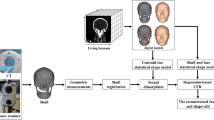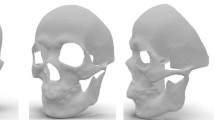Abstract
As an important biological feature of the human, the skull plays an active role in assisting criminal investigation, victim identification, etc. This paper proposes a method based on Sparse Principal Component Analysis (SPCA) for comparison of skull similarity. Compared with Principal Component Analysis (PCA), SPCA can not only effectively reduce the data dimension,but also produce sparse principal components which are easy to explain. Each principal component of PCA is a linear combination of all original variables. It’s difficulty in explaining the corresponding relationship between principal components and features. SPCA makes the loadings sparse, and thus highlights the main part of the principal component, which can solve the problem of PCA that has difficulty in explaining the result. The experimental results show that the dimensionality reduction data by SPCA is superior to PCA in the aspects of complexity, discrimination, stability, interpretability, and similarity evaluation. These indicate that the comparison of skull similarity based on SPCA is accurate and stable, which can provide an effective direction for improving the accuracy of craniofacial reconstruction and obtaining accurate reconstruction results.

















Similar content being viewed by others
References
Breiman L (1993) Better subset selection using the non-negative garotte, Technical report, Univ. of. Cal Berkeley
Cadima J, Jolliffe IT (1995) Loadings and correlations in the interpretation of principal components. Journal of Applied Statistics, pp. 203–214
Claes P, Vandermeulen D, Greef DS, et al. (2006) Craniofacial reconstruction using a combined statistical model of face shape and soft tissue depths: methodology and validation. Forensic Science International, pp. 147–158
Deng Q, Zhou M, Shui W, Wu Z, Ji Y, Bai R (2011) A novel skull registration based on global and local deformations for craniofacial reconstruction. Forensic Sci Int 208(1):95–102
Duan F, Yang Y, Li Y, Tian Y, Lu K, Wu Z, Zhou M (2014) Skull identification via correlation measure between skull and face shape. IEEE Trans Inf Forensics Secur 9(8):1322–1332
Efron B, Hastie T, Johnstone I, Tibshirani R (2004) Least angle regression. The Annals of Statistics, pp. 407–499
Faisan S (2012) A new paradigm to compare a subject to a statistical model. Application to the detection of skull abnormalities. Pattern Recognition Letters, pp. 1309–1315
Fang KT (1989) Practical multivariate statistical analysis, East China Normal University Press
Feng J, Ip HHS, Lap YL, et al. (2008) Robust point correspondence matching and similarity measuring for 3D models by relative angle-context distributions. Image and vision Computing, pp. 761–775
Frank J, Friedman J (1993) A statistical view of some chemometrics regression tools. Technometrics 109:148
Helmer RP et al (1993) Assessment of the reliability of facial reconstruction. Wiley-Liss, New York, pp 229–246
Huang R, Zhao J, et al. (2019) “Automatic craniofacial registration based on radial curves”. Computers Graphics 82:264–274
Hu Y, Duan F, Yin B, Zhou M, Sun Y, Wu Z, Geng G (2013) A hierarchical dense deformable model for 3D face reconstruction from skull[J]. Multimed Tools Appl 64(2):345–364. https://doi.org/10.1007/s11042-012-1005-4
Hui Z, Hastie T (2005) Regularization and variable selection via the elastic net. Journal of the Royal Statistical Society, pp. 301–320
Hui Z, Hastie T, Tibshirani R (2006) Sparse principal component analysis. Journal of Computational and Graphical Statistics, pp. 265–286
Ip W (2002) 3D head models retrieval based on hierarchical facial region similarity. Proceedings of the 15th international conference on vision interface, Calgary, pp. 314–319
Jin W, Li K, Geng G, et al. (2013) A method for evaluating skull and craniofacial similarity. Computer Applied Research, pp. 3124–3127
Jolliffe IT (1995) Rotation of principal components: choice of normalization constraints. Journal of Applied Statistics, pp. 29–35
Jolliffe IT, Trendafilov NT, Uddin M (2003) A Modified Principal Component Technique Based on the LASSO. Journal of Computational & Graphical Statistics, pp. 531–547
Kong S, Cao M, Chen H, et al. (2006) Research on skull recognition based on polar radius invariant moment for CT reconstruction, national joint academic conference on signal and information processing and six-year annual meeting of Shaanxi society of biomedical engineering
Liang R, ye Qian W, Gu H, et al. (2013) The method of craniofacial restoration and evaluation of automatic calibration of feature points. CAD and graphics, pp. 322–330
Li H, Wu Z, Zhou M (2011) A Iso-geodesic Stripes based similarity measure method for 3D face, Biomedical Engineering and Informatics (BMEI). 2011 4th International Conference on IEEE, pp. 2114–2118
Li N (2011) Research and implementation of 3D craniofacial measurement and its similarity evaluation Xi’an: Northwestern University
Li H, Wu Z, Zhou M (2012) Hierarchical evaluation method of craniofacial restoration based on geodesic distance. Papers of the Ninth China Computer Graphics Congress (China Graph’2012), pp. 35–40
Lorensen WE, Cline HE (1987) Marching cubes: A high resolution 3D surface construction algorithm. ACM siggraph computer graphics, ACM 21(4):163–169
Papatheodorou T, Rueckert D (2005) Evaluation of 3D face recognition using registration and PCA, International Conference on Audio-and Video-Based Biometric Person Authentication. Springer, Berlin Heidelberg, pp 997–1009
Ricci A, Marella GL, Apostol MA (2006) A new experimental approach to computer-aided face/skull identification in forensic anthropology. Am J Forensic Med Pathol, pp. 246–49
Shui W (2011) Research and application of craniofacial morphology
Snow CC, Gatliff BP, Mcwilliams KR (2010) Reconstruction of facial features from the skull: An evaluation of its usefulness in forensic anthropology. American Journal of Physical Anthropology, pp. 221–227
Stephan CN, Henneberg M (2001) Building faces from dry skulls: are they recognized above chance rates. Journal of Forensic Sciences, pp. 432–440
Tibshirani R (1996) Regression shrinkage and subset selection with the lasso journal of the royal statistical society
Vanezis M (2008) Forensic facial reconstruction using 3-D computer graphics: evaluation and improvement of its reliability in identification. University of Glasgow, Glasgow
Vines S (2000) Simple principal components. Applied Statistics, pp. 441–451
Wong HS, Cheung KT, Ip HS (2004) 3D head model classification by evoliitionaiy optimization of the extended Gaussian image representation. Pattern Recognition, pp. 2307–2322
Xiru C, Songgui W (1984) Practical regression analysis in modern times Guangxi people’s publishing house
Yuan X, Lu J, Yahagi T (2005) A method of 3d face recognition based on principal component analysis algorithm. Circuits and Systems,ISCAS,IEEE International Symposium, pp. 3211–3214
Zhai G, Ren F (2013) Three-dimensional craniofacial restoration evaluation method based on euclidean geometric distance matrix analysis. Anatomy journal, pp. 377–379
Zhao J, Duan F, Pan Z, et al. (2017) Craniofacial similarity analysis through sparse principal component analysis. Plos One, 12(6)
Zhao J, Liu C, Wu Z, Duan F, Wang K, Jia T, Liu Q (2014) Craniofacial reconstruction evaluation by geodesic network Computational and mathematical methods in medicine
Zhao W, Yang F, Zhang Y (2007) Skull feature recognition based on polynomial fitting. Beijing Biomedical Engineering, pp. 454–457
Zhao W, Yang F, Zhang Y (2008) Calculating and recognizing compound features of skull based on wavelet analysis. Journal of Biomedical Engineering, pp. 1034–1038
Zhao W, Zhang Y, Yang F (2007) Wavelet analysis and identification of skull gray features. Computer Applied Research, pp. 374–376
Zhao W, Xie X, Yang F, et al. (2008) Skull recognition technology based on quadratic rational Bezier curve fitting. Journal of Biomedical Engineering, pp. 280–284
Zhu X, Geng G, Wen C (2012) Using Principal Warps to evaluate craniofacial geometric similarity. Chinese Journal of Image Graphics, pp. 568–574
Zou H, Hastie T (2003) Regression shrinkage and selection via the elastic net,with applications to microarrays. Journal of the Royal Statistical Society
Zhao W, Yang F, Zhang Y (2007) Multi-resolution identication of skull based on Radon transform. Computer Engineering and Applications, pp. 242–245
Acknowledgements
The authors gratefully appreciate the anonymous reviewers for all of their helpful comments. We also acknowledge the support of Xianyang Hospital for providing CT images.This work was supported by the National Natural Science Foundation of China under Grant Nos. 61702293, 61772294, 61572078, 61902203, 11572066 and 11602047, China Postdoctoral Science Foundation No.2017M622137, Key Research and Development Plan - Major Scientific and Technological Innovation Projects of ShanDong Province No.2019JZZY020101, the Open Research Fund of the Ministry of Education Engineering Research Center of Virtual Reality Application of China under Grant No.MEOBNUEV RA201601.
Author information
Authors and Affiliations
Corresponding author
Additional information
Publisher’s note
Springer Nature remains neutral with regard to jurisdictional claims in published maps and institutional affiliations.
Rights and permissions
About this article
Cite this article
Zheng, X., Zhao, J., Lv, Z. et al. Skull similarity comparison based on SPCA. Multimed Tools Appl 79, 22423–22446 (2020). https://doi.org/10.1007/s11042-020-08937-z
Received:
Revised:
Accepted:
Published:
Issue Date:
DOI: https://doi.org/10.1007/s11042-020-08937-z




